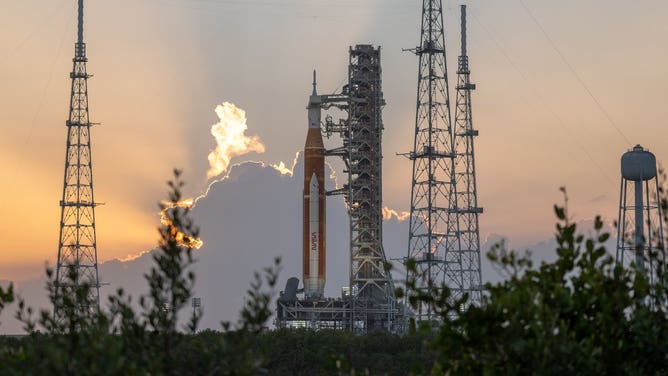NASA delays Artemis 1 launch, prepares for rollback as Hurricane Ian moves toward Florida
NASA is foregoing the Tuesday launch attempt for Artemis-1. Launch weather officers will be closely watching Tropical Storm Ian's development in the coming days for the full decision to rollback.
NASA delays the launch attempt of Artemis 1 due to Ian
NASA said it is making preparations to begin rolling back its mega moon rocket to the Vehicle Assembly Building.
KENNEDY SPACE CENTER, Fla. – After completing a fueling test of its mega moon rocket last week, NASA engineers now have to contend with Hurricane Ian that is aiming for Florida during the next launch attempt.
On Saturday morning, NASA teams decided to stand down on preparing for the Tuesday launch opportunity to allow them time to configure systems for rolling back the SLS rocket and Orion spacecraft to the Vehicle Assembly Building.
NASA engineers deferred a final decision until later in the day on Sunday, to allow for additional data gathering and analysis as Hurricane Ian Ian nears Florida.
"The agency is taking a step-wise approach to its decision-making process to allow the agency to protect its employees by completing a safe roll in time for them to address the needs of their families while also protecting for the option to press ahead with another launch opportunity in the current window if weather predictions improve," per a NASA statement. "NASA continues to rely on the most up-to-date information provided by the National Oceanic and Atmospheric Administration, U.S. Space Force, and the National Hurricane Center."
The moon rocket is vertical at Kennedy Space Center launchpad 39B on Florida's east coast, awaiting its third launch attempt.
If the Artemis 1 managers do decide to roll back due to Hurricane Ian, the process would begin Monday or very early Tuesday morning.
In a Sunday news release, NASA said that despite the tropics, they were waiting for forecast models to improve enough to make a call on whether to roll back the 322-foot-tall Space Launch System rocket and Orion spacecraft.
"NASA continues to closely monitor the weather forecast associated with (Hurricane) Ian as preparations for rolling back the Space Launch System rocket and Orion spacecraft to the Vehicle Assembly Building continue," NASA said in a news release. "The agency is making incremental decisions that prioritize the agency’s people and hardware and its process is in accordance with established NASA policies for tropical storms and hurricanes."
After two previous scrubs due to unruly hydrogen leaks and an engine cooling issue, NASA fueled the SLS with more than 700,000 gallons of cryogenic propellant during a test Monday to determine if engineers had resolved the problems.

The Space Launch System rocket and Orion spacecraft sits on launchpad 39B at Kennedy Space Center ahead of a second launch attempt on Sept. 3, 2022. (Image: NASA)
Overall, NASA management called the test a success.
"There's not an objective that we had that day that we did not achieve," NASA SLS chief engineer John Blevins said.
Next week's launch window was not entirely up to the space agency. NASA first needed approval from the Space Force, which oversees the Eastern Range, to extend the Flight Termination System certification due to safety requirements. The FTS is required on all rockets and would cause the vehicle to self-destruct if it veers off course and threatens the public.
Blevins shared the good news on Friday that both the Sept. 27 and Oct. 2 backup dates were approved by the Space Force.
Now NASA will just have to make sure a tropical system doesn't ruin its launch backup date.
In the past week, the tropics have become full of activity after a slow start to the Atlantic hurricane season.
WHAT IS THE ‘CONE OF UNCERTAINTY' IN HURRICANE FORECASTS?
"The latest information provided by the National Oceanic and Atmospheric Administration, the U.S. Space Force, and the National Hurricane Center indicates a slower moving and potentially more westerly track of the storm than yesterday’s predictions showed, providing more time for the agency’s decision-making process and for employees to prioritize their families should the storm impact the Kennedy Space Center area," NASA said in a new release.

(FOX Weather)
This particular system will be a factor in any upcoming Artemis launch attempt because Hurricane Ian is forecast to strengthen into a hurricane and with expected landfall on the Florida Peninsula this week.
The latest cone of uncertainty covers Central Florida, including NASA's Kennedy Space Center, the Florida Peninsula and the Florida Panhandle.
If a tropical system does bring strong winds to Florida's Space Coast, NASA would need to roll the 322-foot-tall rocket back into the Vehicle Assembly Building. That 2-mph move to the hangar cannot happen in winds over 46 mph but stationary at the pad the rocket can withstand 74 Knots.
Stay with FOX Weather for the latest on Tropical Storm Ian.
